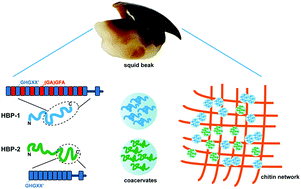Self-coacervation of modular squid beak proteins – a comparative study†
Abstract
The beak of the Humboldt squid is a biocomposite material made solely of organic components – chitin and proteins – which exhibits 200-fold stiffness and hardness gradients from the soft base to the exceptionally hard tip (rostrum). The outstanding mechanical properties of the squid beak are achieved via controlled hydration and impregnation of the chitin-based scaffold by protein coacervates. Molecular-based understanding of these proteins is essential to mimic the natural beak material. Here, we present detailed studies of two histidine-rich beak proteins (HBP-1 and -2) that play central roles during beak bio-fabrication. We show that both proteins have the ability to self-coacervate, which is governed intrinsically by the sequence modularity of their C-terminus and extrinsically by pH and ionic strength. We demonstrate that HBPs possess dynamic structures in solution and achieve maximum folding in the coacervate state, and propose that their self-coacervation is driven by hydrophobic interactions following charge neutralization through salt-screening. Finally, we show that subtle differences in the modular repeats of HBPs result in significant changes in the rheological response of the coacervates. This knowledge may be exploited to design self-coacervating polypeptides for a wide range of engineering and biomedical applications, for example bio-inspired composite materials, smart hydrogels and adhesives, and biomedical implants.

- This article is part of the themed collection: Complex Coacervation


 Please wait while we load your content...
Please wait while we load your content...